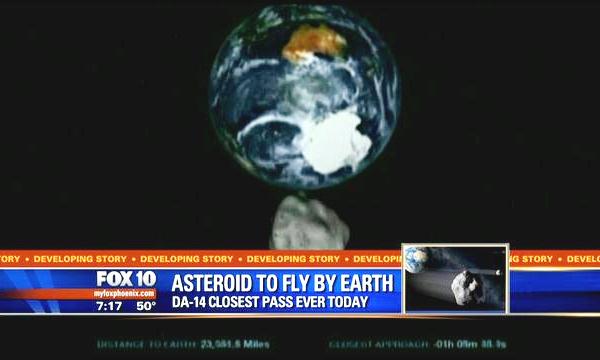

| Visitors Now: | |
| Total Visits: | |
| Total Stories: |

| Story Views | |
| Now: | |
| Last Hour: | |
| Last 24 Hours: | |
| Total: | |
One Hour Until Enormous DA-14 Asteroid Comes Within 17,150 Miles Of Earth
RELATED STORY: Meteorite Crash In Russia Sparks UFO Fears As Mass Panic Ensues
CAPE CANAVERAL, Fla. – An asteroid hurtled toward Earth’s backyard, destined Friday to make the closest known flyby for a rock of its 150-foot size. In a startling coincidence, a meteor exploded above Russia’s Ural Mountains just hours before the asteroid was due to zoom past the planet.
Scientists insisted the meteor had nothing to do with the incoming asteroid since they appeared to traveling in opposite directions. The asteroid is much more immense object that was expected to miss Earth by 17,150 miles, avoiding catastrophe.
But that’s still closer than many communication and weather satellites. Scientists insisted these, too, would be spared.
‘These fireballs happen about once a day or so, but we just don’t see them because many of them fall over the ocean or in remote areas.’ – Jim Green, NASA’s director of planetary science
Scientists at NASA’s Near-Earth Object program at California’s Jet Propulsion Laboratory estimate that an object of this size makes a close approach like this every 40 years. The likelihood of a strike is every 1,200 years.
But Friday’s meteor impact further strengthened the resolve of some to protect the Earth against dangerous asteroids.
“We are in a shooting gallery, and this is graphic evidence of it,” said former Apollo astronaut Rusty Schweickart, chairman emeritus of the B612 Foundation, committed to that goal.
The best viewing locations, with binoculars and telescopes, are in Asia, Australia and eastern Europe. Even there, all anyone can see is a pinpoint of light as the asteroid zooms by at 17,400 mph.
As asteroids go, DA14 is a shrimp. The one that wiped out the dinosaurs 65 million years ago was 6 miles across. But this rock could still do immense damage if it struck given its 143,000-ton heft, releasing the energy equivalent of 2.4 million tons of TNT and wiping out 750 square miles.
By comparison, the meteor that emitted sonic blasts nearly 1,000 miles east of Moscow, shattered windows and injured hundreds weighed an estimated 10 tons.
As for the back-to-back events, “this is indeed very rare and it is historic,” said Jim Green, NASA’s director of planetary science.
“These fireballs happen about once a day or so, but we just don’t see them because many of them fall over the ocean or in remote areas. This one was an exception,” he said on NASA TV.
As the countdown to Asteroid DA14′s close approach entered the final hours, NASA noted on its website that the path of the meteor appeared to be quite different than that of the asteroid, making the two objects “completely unrelated.” The meteor seemed to be traveling from north to south, while the asteroid was due to pass from south to north — in the opposite direction.
Most of the solar system’s asteroids are situated in a belt between the orbits of Mars and Jupiter, and remain stable there for billions of years. Some occasionally pop out, though, into Earth’s neighborhood.
The flyby provides a rare learning opportunity for scientists eager to keep future asteroids at bay.
Schweickart noted that 500,000 to 1 million sizable near-Earth objects — asteroids or comets — are out there. Yet less than 1 percent — fewer than 10,000 — have been inventoried.
Humanity has to do better, he said. The foundation is working to build and launch an infrared space telescope to find and track threatening asteroids.
DA14 — discovered by Spanish astronomers last February — is “such a close call” that it is a “celestial torpedo across the bow of spaceship Earth,” Schweickart said in a phone interview Thursday.
Astronomers organized asteroid-encounter parties for Friday, and experts just about everywhere were giving flyby rundowns.
NASA’s deep-space antenna in California’s Mojave Desert was ready to collect radar images, but not until eight hours after the closest approach given the United States’ poor positioning for the big event.
If a killer asteroid was, indeed, incoming, a spacecraft could, in theory, be launched to nudge the asteroid out of Earth’s way, changing its speed and the point of intersection. A second spacecraft would make a slight alteration in the path of the asteroid and ensure it never intersects with the planet again, Schweickart said. source – Fox News
The post One Hour Until Enormous DA-14 Asteroid Comes Within 17,150 Miles Of Earth appeared first on Now The End Begins.
2013-02-15 12:00:25
Source:



